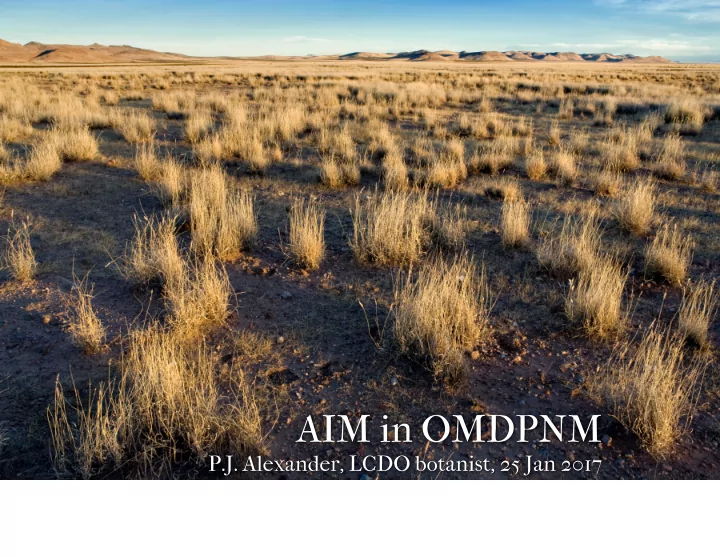

AIM methods • photographs • line-point intercept with veg. heights • canopy gap • soil stability • soil pit (first plot visit) • plot species inventory supplementary • plant production
plot photographs
line-point intercept • recorded every 25 cm along transects
line-point intercept • a pin flag (minus the flag) is dropped vertically at the appropriate point on the transect • any plants touching the pin are recorded, as well as the soil surface • used to estimate % cover of different plants, % of soil covered by litter, % rock cover, % bare ground • analogous to boot tip pace transects, but more accurate
vegetation height • recorded every 2.5 meters along each transect • particularly useful for wildlife habitat (e.g., cover for greater sage-grouse)
canopy gap • records the spatial distribution of vegetation: are there lots of small, evenly-spaced plants, or a few big clumps?
soil stability test • a small ped (piece of the soil surface) is collected, placed in a piece of PVC pipe with mesh at the bottom
soil stability test • soil stability is determined by how quickly the ped dissolves in water & with agitation (“dips”) to estimate how easily the soil will erode
soil pit • dug to 70 cm or until an impermeable layer (e.g., caliche) is reached • texture, color, % rock, & effervescence recorded for each soil horizon • used in AIM primarily to verify ecological site identification
electronic data capture • data is stored in DIMA, a Microsoft Access database • electronic data entry reduces the work of data entry in the office and increases our ability to catch errors in the field
plot species inventory • record all plant species occurring on the plot • estimates plant biodiversity across the landscape, records plants too sparse to show up in line-point intercept plant production • follows the protocols of LCDO range condition / trend plots • estimates forage production for stocking rate calculations • can be compared with production-based reference conditions for ecological sites • measured only on plots that fit our traditional criteria for range plot location: not within the sacrifice zone of a livestock water, but close enough to a water that it is used by livestock training videos for all of these methods are online http://www.landscapetoolbox.org/training/resources/
Sample design: spatially-balanced stratified random sampling • define the sample area • all BLM land within allotments that intersect the monuments • decide on sample size • 300 plots, based on 60 plots per year, 5-year revisit cycle • split the sample area into smaller pieces (strata) • based on ecological sites • decide how many plots we want to put into each stratum • based on acreage and variation / ROVs in each stratum • within each stratum, plots are random but spatially balanced (not as “clumpy” are purely random sampling)
total study area
strata
2016 plot locations
Recommend
More recommend